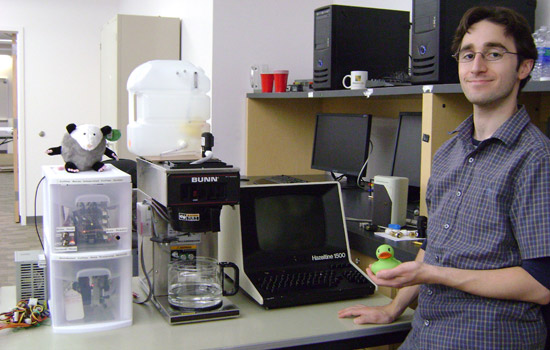What’s brewing? Engineering a better coffee maker
The Coffee Baron makes for a savory senior design project
Michelle Cometa
Osman Celimli, a fifth-year computer engineering major, led a team that developed the Coffee Baron, a distributed-computing solution for office coffee makers. The system is made up of refurbished microprocessors, old Game Boy components and a rubber duck to indicate the volume of water in the water dispenser.
Move over Bunn, Keurig and Krups, there’s a new coffee maker in town—and it’s built using a refurbished 35-year-old computer, discarded ink cartridges and a Game Boy.
The Coffee Baron is a combination of coffee brewer, similar to those used in department offices or homes, connected to a computer network. Users in an office, for example, can connect to the system through a desktop Web browser or by using a mobile phone to get an update about the “state-of-the-coffee machine” and the availability of freshly brewed Arabica, Kona or espresso.
“You could be sitting at your desk and wonder if there is coffee in the pot. You’d be able to check before getting up to get it, and even have it poured by the time you arrive,” says Osman Celimli, a fifth-year computer engineering major and one of the three Coffee Baron designers.
“One of our interests is distributed computing, so we have multiple, similar computers processing different elements of the task through several small microcontrollers,” says Celimli, who is from Boston.
The team modeled the Coffee Baron after the large machines found in Starbucks cafés that grind beans and brew coffee in essentially one step. However, the café machines are nearly room-size, and the process is managed by baristas. Celimli’s project puts brewing in the hands of office or home “baristas”—and allows them to manage the process remotely.
Using some engineering ingenuity, Celimli, Corey Bloodstein and Anthony Agresta saw the senior project of managing the coffee processes remotely as a fun design problem, nothing a little automation and whimsy could not solve. The whimsy includes a stacked-deck of older model microprocessors that were refurbished by the three computer engineering majors and installed with other parts that, under ordinary circumstances, would have been candidates for the garbage or recycle bins.
“I work as a lab assistant,” Celimli says, “and what happens is old equipment trickles down to me. We decided to use as much of it as possible.”
All the components that are managing the “state-of-the-coffee machine” are basically from scrap. The arm that moves across the top of the coffee pot is built out of a Game Boy cartridge; it has sensors that indicate coffee temperature and liquid volume. While the team connected a 35-year-old Hazeltine computer that needs some coaxing to work, they also have the system fully connected to a modern desktop and server. All the electronic boxes are old ink cartridges and the components are housed in a plastic storage container from Walmart. The water tank is a clear plastic carafe atop the machine with a yellow rubber duck inside to indicate water level.
The automated features run using a student-designed computer protocol called CoffeeTalk that communicates with all the microcontrollers. It is this protocol that puts the machine in the hands of users—even from a distance.
“There’s a huge amount of engineering involved to get the whole distributed system working, but it’s a great combination of old and new for something we have to have every morning, because the best part of waking up is Folger’s in your cup,” he says. (Yes, the machine is programmed with several coffee-themed jingles.)
Note: The Coffee Baron brew masters will distribute fresh beverages for guests in Erdle Commons, on the first floor of the Kate Gleason College of Engineering, as part of the Imagine RIT: Innovation and Creativity Festival, May 5.










